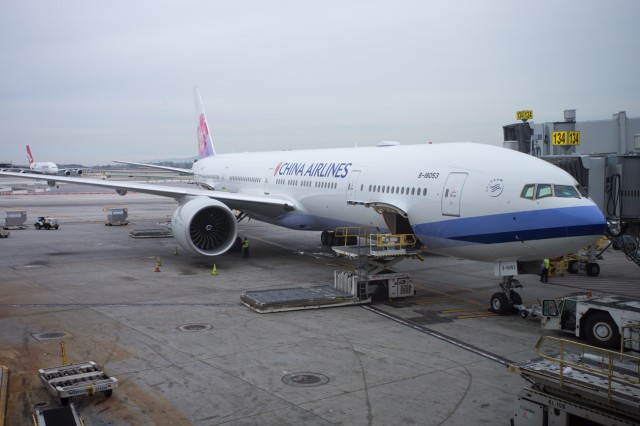
China Airlines’ Boeing 777-300ER – Photo: Jeremy Dwyer-Lindgren
When China Airlines unveiled its new Boeing 777-300ER back in early October of this year, it was clear that this airplane was something special. Photos and videos of the new interioroutfitted with a snazzy new business cabin, homages to Taiwanese culture, and a small libraryquickly made the internet rounds, establishing this plane as the hot new item in the air.
Having seen it myself in Seattle, I knew it had to try it once it was released into the wild. Fast forward two months to last Monday (December 1), when I found myself, ticket in hand, ready to board China Airlines flight 5, service from Los Angeles LAX to Taipei. AirlineReporter/NYCAviation were invited by the airline to sample the carrier’s promising-looking new business class. The formal adventure began in the lounge at Los Angeles International Airport.
China Airlines (CAL), does not have one of its own at the airport, and thus utilizes Korean’s SkyTeam lounge instead. As far as lounges go, this one runs above average, largely thanks to its new-ness and an exterior deck overlooking the main hall. I helped myself to a few finger sandwiches and a beverage while checking email on the free WiFi. Boarding began on time at gate 134. Holding a ticket for the carrier’s premium business class, I boarded quickly via a dedicated jet-way connected to the L1 door.
Those with business tickets are split between two cabins, and today’s seat22Awas in the rear section nestled behind the L2 door. Both cabins are set up in a reverse herringbone style in a 1-2-1 configuration. As boarding continued, cabin crew offered a selection of non-alcoholic pre-flight drinks and hot towels. Bags and personal items slipped easily into overhead bins or into one of three built-in storage areas in the seat. The giant Boeing 777-300ER easily lifted off runway 25R and turned northwest to head up the California coast for the scheduled 14-hour flight to Taipei’s Taoyuan International Airport.
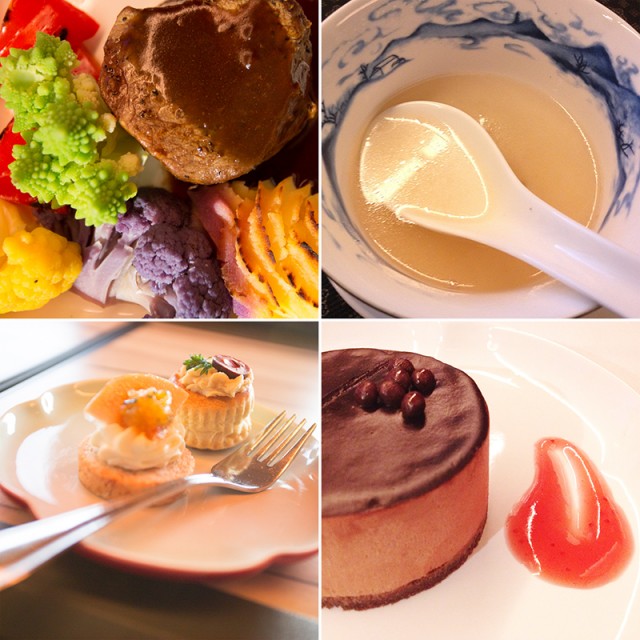
Some of the food offered during my flights – Photo: Jeremy Dwyer-Lindgren
THE FOOD
The first of two meal services began not long after departure. A drink service with a small appetizer came first, and I chose to start the long flight with a whiskey on ice. A larger appetizer plate followed, consisting of a roast beef rosette with pesto aioli, steamed flower prawn, jellyfish salad, Cantonese pickles, leafy salad with balsamic dressing, and a braised pork rib with lily flower soup. The soup was especially delightful, placed inside a beautifully-crafted bowl adorned with a traditional Chinese ink landscape.
The bowl was designed to complement the clear soup, the airline says, so as to create the illusion of a little lake scene right there in the bowl. Right about the time my soup bowl town began experiencing a severe drought the main course arrived: pan-seared beef filet. It was accompanied by duchess pomme (fancy mashed potatoes) and heirloom cauliflower with bordelaise sauce. Each was excellent. The meal was capped with an extremely tasty, and dense, chocolate mousse cake. In between meal services the star attraction, called the Sky Lounge, opens up for business.
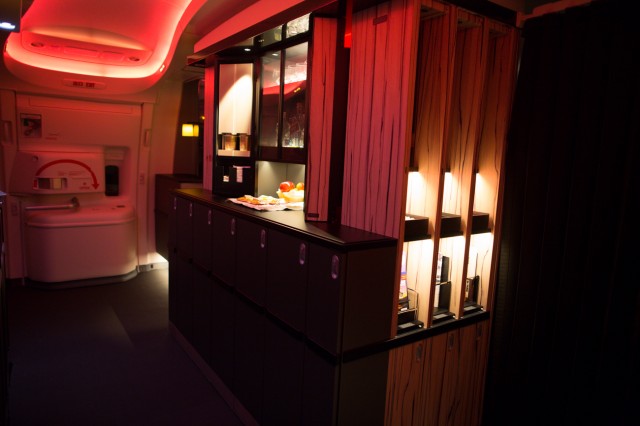
The Sky Lounge provides additional food and drinks for premium passengers – Photo: Jeremy Dwyer-Lindgren
Modeled after a traditional teahouse, the space does not disappoint. High ceilings with mood lighting create an open feel, while wood grain paneling (same as in the seat and on the walls) adds to a classy, yet homey atmosphere. Located between the business cabins, one can stop by for a cup of hot noodles, a stiff drink to settle you down, or a coffee to pick you up. Coffee or alcohol not your thing? Try one of six Taiwanese teas or treats. It is an excellent addition, and not to be missed.
The second meal service was served two hours prior to scheduled landing, and called breakfast despite being late evening in Taipei. Feeling adventurous I chose the Chinese breakfast over the standard Western fare. It was based around plain congee (rice porridge), which by itself is exceptionally bland. But several delicatessen, including stir-fried double-colored fungus, shredded dry pork, and braised bean curd with bamboo pitch and pork helped liven it up. A steamed bun and assorted fresh fruits were also included. Related, my chopstick skills remain a work in progress.
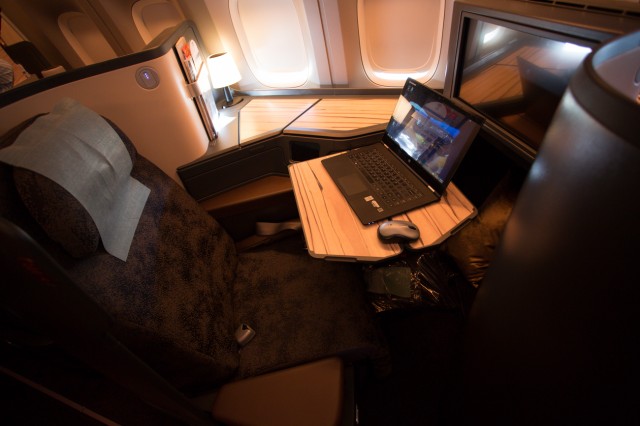
China Airlines’ Business Class seat in “work mode” – Photo: Jeremy Dwyer-Lindgren
THE BUSINESS CLASS SEAT
Based on the B/E Aerospace Super Diamond, it features 28 inches of width and a full-flat recline with 78 inches of length. Some of the notable features include two USB power ports, one international power outlet, a reading light and lamp, memory foam seat cushion, and three separate storage areas of varying size and capacity.
It is decidedly high-tech, with a touchscreen control embedded in the arm rest that controls seat adjustments, lights, and other functions instead of standard buttons.
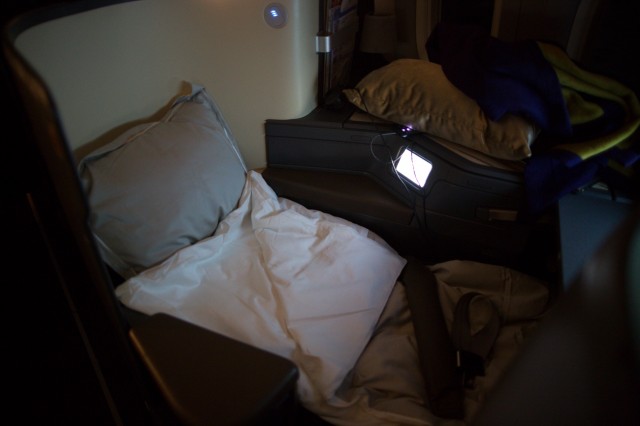
The Business Class seat ready to be slept in – Photo: Jeremy Dwyer-Lindgren
It additionally features faux persimmon wood surfaces, the same as the paneling found elsewhere on board. The otherwise dark color palette of grays, browns, and blacks combined with the soft lighting of the lamp or overhead LED mood lighting to create a calming ambient atmosphere. Once ready to sleep, a friendly crew member provided a turn-down service, readying the bed with a sort of fancy sleeping bag and heavier blanket than the one initially provided. The process takes a few minutes. I slept for three hours, not because of a lack of comfort but for a need to keep to my jet-lag adjustment plan.
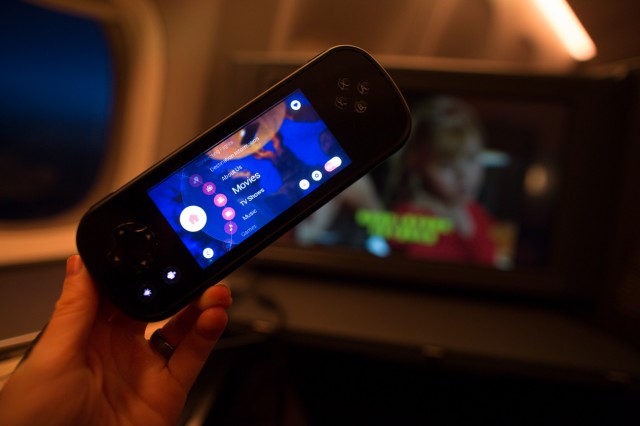
The entertainment system on the China Airlines’ 777-300ER – Photo: Jeremy Dwyer-Lindgren
The Entertainment & Extras
The seat also features an 18-inch touchscreen featuring a plethora of content, though American travelers will find many of the options a bit on the older side in terms of video. The system can be further controlled by a handheld tethered controller, which itself has a 4.1-inch screen that can display content independent of the main screen. Run by Panasonic’s powerful eX3 system, it features the usual suspects for a built-in entertainment system.
Movies, games, TV, and audio anchor the system, containing a predictable line-up of Western as well as Taiwanese content. Lesser used features such as seat to seat instant messaging/chat, e-Reader, and a beautiful 3D map app provided additional ways to keep busy. The flight also had WiFi, as many have gathered from our on-board social media posting last Monday. Run by Panasonic, its performance proved unreliable.
Upload speeds were slow, and it frequently cut out. My return flight, however, did not suffer the same issues. Pricing ran from $12 for an hour to $22 for the day. An Acca Kappa amenity kit containing an eyeshade, wellness products, and toothpaste/brush was also provided. A noise-cancelling headset was also provided.
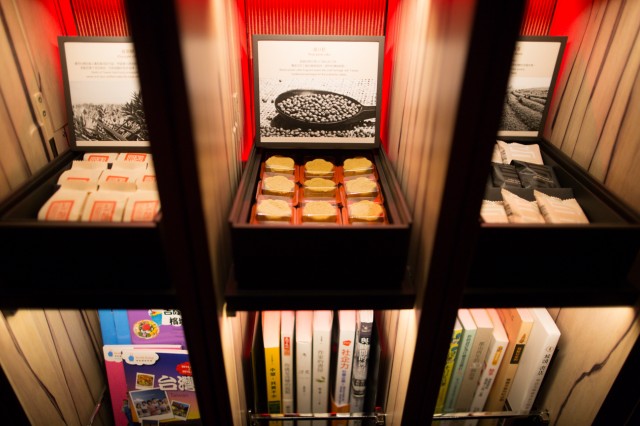
The Sky Lounge offers a number of goodies for passengers – Photo: Jeremy Dwyer-Lindgren
Culture
While the seat and service were excellent, what really took the experience to the next level was the exceptional attention to detail and culture. The cabin was full of nods to Taiwanese culture that continued to delight throughout the flight as they were discovered. The ink painting motif could be found in more than just the soup bowl: Each lavatory had a unique painting. Selected poetry is etched into the sidewalls of the Sky Lounge. Each tea selection from the loungethere are sixis sourced from Taiwan, as is the coffee. The desserts follow suit.
The lounge also features a small library, the first that I’ve ever seen on an airplane, with a rotating selection of popular books in both English and Chinese along with destination guides. Cultural videos, available in multiple languages, were available as part of the AVOD, educating visitors on the sights and sounds of Taiwan. It guided me towards several foods to try and places to visit during my short stay in Taipei.
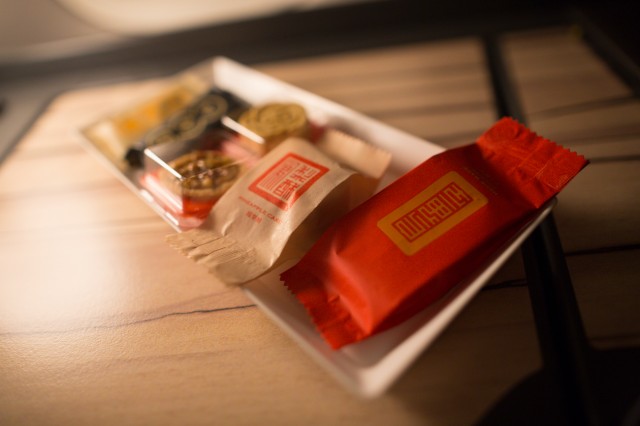
The small touches, like these snacks, really stand out – Photo: Jeremy Dwyer-Lindgren
Post-flight breakdown
China Airlines’ premium cabin hasn’t exactly been the belle of the ball in recent years. A lackluster product left it lagging behind regional competitors, particularly chief rival Taipei-based EVA Airways. But those days are on the way out. The hard product is among the very best this author has sampled to date; an excellent mashup of classic comfort, practical amenities, and high-tech gadgetry. It is a massive improvement over the product currently available on the carrier’s Airbus A330/40 and Boeing 747 long-haul fleet.
More importantly, there is no question the new cabin is at least exceptionally competitive against its peers, and I would be surprised if it isn’t at or close to the top of the pack (which I say only because I haven’t tried all of its competitors).
The service was generally excellent, though it should be noted that the crew was made aware of my presence as a reviewer. Attempting to balance the potential bias I talked with maybe half a dozen frequent flyers on board during the flight (and even more on a subsequent venture), all of which praised the service and recent improvements. Most impressive, however, remains the truly astonishing level of detail and intentionality built into the cabin design, service, and cultural touch-points. Some of the aspects, like the poetry, I knew about beforehand. Others, like the soup bowl or the lav music, were all pleasant surprises that added a new and unexpected twist. The airplane, at least in business, more than succeeds in its mission to be an ambassador for the country. I’ve yet to see another carrier come even close. CAL no doubt made an excellent choice in designer Ray Chen, who will also be designing the carrier’s Airbus A350 interior.
So much so that many passengers will likely miss a fair bit of it. A pamphlet inserted into the seat-back could be helpful in conveying some of the more hidden elements, such as the plum blossom logo/shape imprinted on the underside of each plate. Combine the high-tech gadgetry with the classy ambience and uniquely cultural flair and well, I was extremely impressed. Having seen the interior in Seattle myself at delivery and having spoken with management at length about many of the service elements they looked to roll out, I had built up very high expectations. I’m pleased to share that my expectations were not just met, but exceeded.
Looking to book? For the foreseeable future this flagship product will only be available on the carrier’s growing fleet on Boeing 777s. The airplane currently also only serves Los Angeles, though service to New York and San Francisco is expected in 2015. The carrier is part of the SkyTeam alliance, for those considering travel via miles.
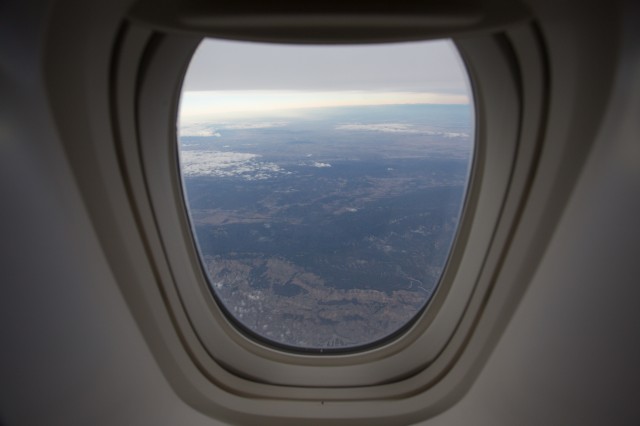
Out the window of the 777-300ER – Photo: Jeremy Dwyer-Lindgren
Bottom line
Fifteen hours and 21 minutes aloft wasn’t long enough. The combination of a great seat, good food, friendly service, and most of all the myriad delightful design points made China Airlines’ 777 business class a memorable experience for all the right reasons.
This story was written by Jeremy Dwyer-Lindgren for AirlineReporter and NYCAviation. China Airlines covered the author’s flights, but his opinions are his own.
Only thing missing: Flight attendant pictures ;-).
Thank you for your thorough review. I’ve been a frequent Royal Laurel business class flyer on EVA to TPE from SFO for over 10 years averaging 3 to 4 times annually and more recently in their Royal Laurel Business Class. In the 70 and 80’s prior to EVA, I flew CAL 747SP. You’re probably aware that CAL was started and owned by the Chinese Nationalist Party controlled government and now is still partially state subsidized. It had the moniker “Flag Carrier of the Republic of China” on the vertical stabilizer and/or fuselage. Your review is thorough and impressive and no doubt accurate. Its never too late that CAL finally is competitive as far as business class amenities are concerned. Being a Taiwanese carrier it should not be named China Airlines. At the very least, a misnomer. Easily confused with Air China. Also while you mention “Taiwanese” culture in your review, it is actually Chinese culture. And the so called Chinese breakfast actually is classic Taiwanese breakfast. True Taiwanese culture is often misrepresented or trivialize typically by Chinese mainlanders in Taiwan and elsewhere.
Hahahhhahhahahhaha
I flew EVA SFO-TPE last September, also in Royal Laurel Class. While I found the EVA experience excellent, indeed one of the best flights I’ve ever head, it’s clear from your pictures and story that China Air is moving to best EVA and I think they may succeed here.
Competition at its best- CAL finally rising to EVA’s level and perhaps beyond.
Echoing Joe from above, if only the name of the airline would only match the “Taiwanese” touches found throughout the plane, that would be a step forward. I bet the average business traveler would not think to pick China Airlines to Taipei based on its name alone- maybe to Beijing or Shanghai, perhaps. This is something not even the best PR can correct- you need a name change.
show amenity kit!
Although the service may seem good, CAL has been known to lose bags A LOT. also, they service standard is not up to EVA, which is a phenomenal airline. Along with that, CAL is not very popular in the US because of its abysmal safety record. EVA serves ~60 flights to the US while CAL only serves ~35. CAL will never rise above EVA because of its bad reputation. GO EVA and Star Alliance!!!